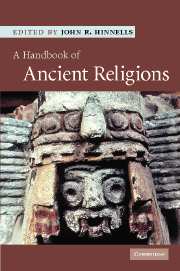Book contents
- Frontmatter
- Contents
- List of illustrations
- List of maps
- List of tables
- List of contributors
- Introduction
- 1 Palaeolithic art and religion
- 2 Ancient Egypt
- 3 Religion in ancient Ugarit
- 4 Mesopotamia
- 5 Ancient Israel to the fall of the Second Temple
- 6 Greek religion
- 7 Religions in the Roman Empire
- 8 Ancient Europe
- 9 The Indus Civilization
- 10 The religion of ancient China
- 11 Aztec and Inca civilizations
- Index
- References
1 - Palaeolithic art and religion
- Frontmatter
- Contents
- List of illustrations
- List of maps
- List of tables
- List of contributors
- Introduction
- 1 Palaeolithic art and religion
- 2 Ancient Egypt
- 3 Religion in ancient Ugarit
- 4 Mesopotamia
- 5 Ancient Israel to the fall of the Second Temple
- 6 Greek religion
- 7 Religions in the Roman Empire
- 8 Ancient Europe
- 9 The Indus Civilization
- 10 The religion of ancient China
- 11 Aztec and Inca civilizations
- Index
- References
Summary
Introduction
Towards the end of the eighteenth century, Edmund Burke contemplated the essence of mankind: he wrote, ‘Man is by his constitution a religious animal.’ In the second half of the twentieth century, we have had other definitions: Man the Toolmaker and Man the Symbol-Maker, the second being a reworking of Burke's feeling that the defining trait of ‘man’ is in some way or other ‘spiritual’ or non-material. Whether one adopts a technological, a cognitive or a spiritual definition, the intertwined roots of ur-religion (the hypothetical ‘original’ religion), the beliefs and practices that preceded what we know today as ‘religion’, lie deep in prehistory.
The word ‘prehistory’ is generally applied to the extremely long period that stretches from the origins of humankind, about 3 million years or more ago, to the advent of writing. In some regions, such as the Middle East, writing led to profound social changes many thousands of years ago, while in other parts of the world the impact of writing was not felt until contact with European colonists, sometimes not until the nineteenth or even the beginning of the twentieth century. We are thus dealing with immense periods of time about which – in most cases – we know next to nothing. Unlike some other chapters in this book, this one can draw on neither inscriptions nor texts; nor can its writers question prehistoric people about their beliefs.
- Type
- Chapter
- Information
- A Handbook of Ancient Religions , pp. 7 - 45Publisher: Cambridge University PressPrint publication year: 2007
References
- 3
- Cited by



